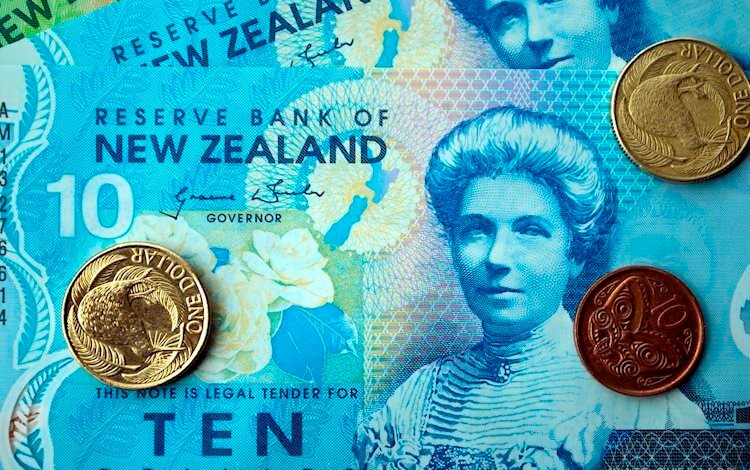New Zealand Dollar gathers strength to ten-week highs on weaker US Dollar

- The New Zealand Dollar extends its upside in Wednesday’s early Asian session.
- The softer US Dollar and positive risk sentiment support NZD/USD.
- Investors will focus on the first reading of US August S&P Global PMI on Wednesday.
The New Zealand Dollar (NZD) edges higher on Wednesday as the USD Index (DXY) extended its decline to near yearly lows. The improved risk sentiment after China rolled out further measures to support the real estate sector boosts the Kiwi as China is New Zealand’s largest trading partner.
On the other hand, the dovish remarks from the Reserve Bank of New Zealand (RBNZ) after a surprise rate cut last week might limit the pair’s upside. Investors will keep an eye on the preliminary US S&P Global PMI for August, which is due on Wednesday. All eyes will be on Fed Chair Powell’s speech at the Jackson Hole symposium on Friday. Any dovish comments from Powell are likely to undermine the USD and create a tailwind for NZD/USD.
Daily Digest Market Movers: New Zealand Dollar remains strong amid a dovish Fed
- The People’s Bank of China (PBOC) decided to hold the one-year and five-year Loan Prime Rates (LPR) steady on Tuesday at 3.35% and 3.85%, respectively.
- China implemented further measures to boost the real estate sector. At least 10 city governments in China have relaxed or scrapped new-home price guidelines to allow market demand to play a bigger role, per Bloomberg.
- New Zealand’s Trade Balance arrived at NZD -$9.29B YoY in July versus $-9.5B prior. Exports decreased to $6.15B in July versus $6.17B in June, whereas Imports increased to $7.11B compared to $5.45B in previous readings.
- Federal Reserve (Fed) Governor Michelle Bowman said on Tuesday that she remains cautious about any shift in the policy because of what she sees as continued upside risks for inflation. She warned that overreacting to any single data point could jeopardize the progress already made, per Reuters.
- The markets are now pricing in a nearly 67.5% odds of a 25 basis points (bps) Fed rate cut in its September meeting, down from 77% on Tuesday, according to the CME FedWatch Tool.
Technical Analysis: New Zealand Dollar resumes its constructive outlook
The New Zealand Dollar trades on a stronger note on the day. The NZD/USD pair keeps the bullish vibe on the daily chart as the pair holds above the descending trendline and the key 100-day Exponential Moving Average (EMA). The upward momentum is bolstered by the 14-day Relative Strength Index (RSI), which stands above the midline near 65.60, suggesting that further upside looks favorable.
The immediate resistance level emerges at 0.6222, the high of June 12. Further north, the next hurdle is seen at 0.6279, a high of January 12. The additional upside filter to watch is 0.6360, a high of December 29, 2023.
On the downside, the 0.6130 psychological mark acts as an initial support level for the pair. The next contention level is located near the resistance-turned-support level at 0.6070. Sustained trading below this level could lead to a drop towards 0.5974, the low of August 15.
New Zealand Dollar FAQs
The New Zealand Dollar (NZD), also known as the Kiwi, is a well-known traded currency among investors. Its value is broadly determined by the health of the New Zealand economy and the country’s central bank policy. Still, there are some unique particularities that also can make NZD move. The performance of the Chinese economy tends to move the Kiwi because China is New Zealand’s biggest trading partner. Bad news for the Chinese economy likely means less New Zealand exports to the country, hitting the economy and thus its currency. Another factor moving NZD is dairy prices as the dairy industry is New Zealand’s main export. High dairy prices boost export income, contributing positively to the economy and thus to the NZD.
The Reserve Bank of New Zealand (RBNZ) aims to achieve and maintain an inflation rate between 1% and 3% over the medium term, with a focus to keep it near the 2% mid-point. To this end, the bank sets an appropriate level of interest rates. When inflation is too high, the RBNZ will increase interest rates to cool the economy, but the move will also make bond yields higher, increasing investors’ appeal to invest in the country and thus boosting NZD. On the contrary, lower interest rates tend to weaken NZD. The so-called rate differential, or how rates in New Zealand are or are expected to be compared to the ones set by the US Federal Reserve, can also play a key role in moving the NZD/USD pair.
Macroeconomic data releases in New Zealand are key to assess the state of the economy and can impact the New Zealand Dollar’s (NZD) valuation. A strong economy, based on high economic growth, low unemployment and high confidence is good for NZD. High economic growth attracts foreign investment and may encourage the Reserve Bank of New Zealand to increase interest rates, if this economic strength comes together with elevated inflation. Conversely, if economic data is weak, NZD is likely to depreciate.
The New Zealand Dollar (NZD) tends to strengthen during risk-on periods, or when investors perceive that broader market risks are low and are optimistic about growth. This tends to lead to a more favorable outlook for commodities and so-called ‘commodity currencies’ such as the Kiwi. Conversely, NZD tends to weaken at times of market turbulence or economic uncertainty as investors tend to sell higher-risk assets and flee to the more-stable safe havens.
Source link






